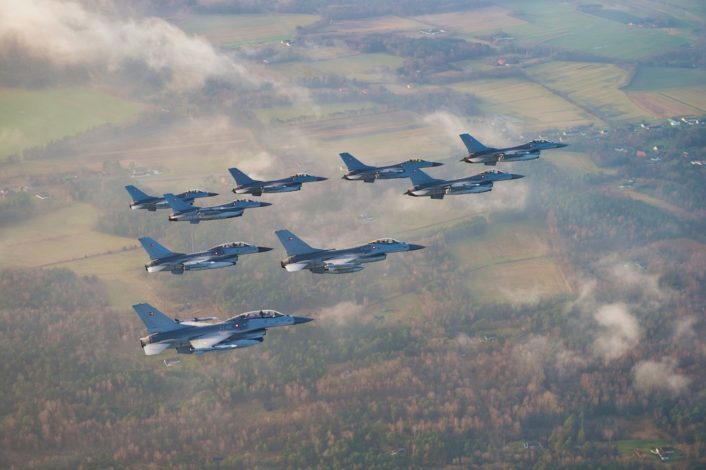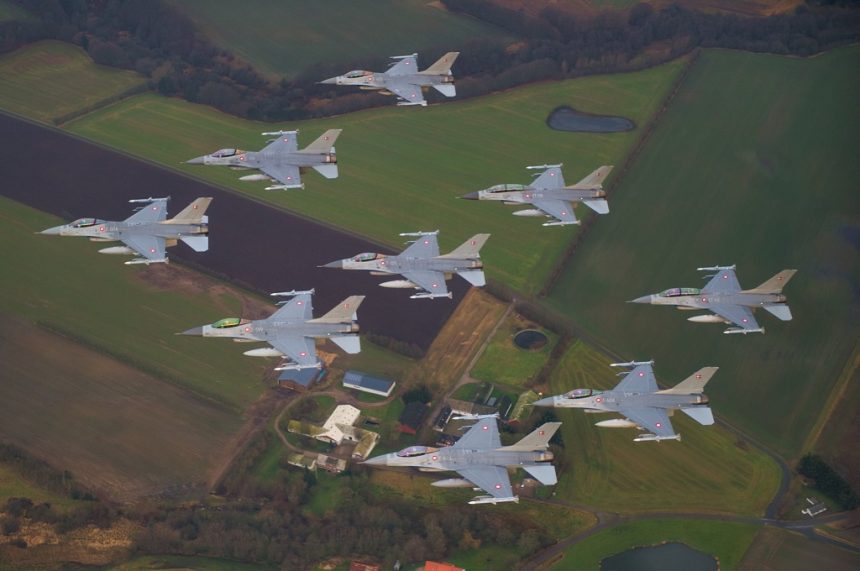The anniversary was marked by two formation flights of 10 F-16s over the country.
On Jan. 17, 2020, the Royal Danish Air Force celebrated the 40th anniversary since the acceptance of the first F-16.
For the occasion, the F-16s from Fighter Wing Skrydstrup conducted two 10-ship formation flights over Denmark at low altitude and they could also be followed through online flight tracking websites with the celebratory callsign F1640, as announced by the RDAF’s website and social medias.
Since the official celebration was a closed event only for the airport’s personnel and a few guests, according to the RDAF, the flight was to be performed at 2,000 ft and in good weather, so the ten Fighting Falcons (or, “Vipers” as the F-16s are dubbed within the fighter pilots community) could be seen from the ground and share this way the event with the Danish population.
De danske F-16 kampfly runder 40 år – det fejrer @forsvaretdk i dag med en større 10-skibs formationsflyvning over Danmark. Læs mere: https://t.co/p0ft1HNp18 #værdatkæmpefor #dkforsvar pic.twitter.com/qb0VUXJtFu
— Forsvaret (@forsvaretdk) January 17, 2020
Dagens formationsflyvning over Danmark kan følges direkte på mobiltelefonen via diverse Flight Tracker APPs. Søg efter ”F1640” (5 cifre) og følg formationen live. #værdatkæmpefor #dkforsvar pic.twitter.com/RnskOCavxR
— Forsvaret (@forsvaretdk) January 17, 2020
This anniversary occurs just a few days before the 46th anniversary of the first, unofficial, first flight of the YF-16. As you may know, this first flight occurred during a high-speed taxi test on Jan. 20, 1974 as the aircraft experienced heavy oscillations and the test pilot decided to take off in order to avoid a potential crash. The first official flight happened two weeks later, on Feb. 2.
Denmark bought a total of 77 F-16A/Bs through two major orders of 58 and 12 jets in the 1980s and two attrition replacement orders of 3 and 4 aircraft in the 1990s. The RDAF currently has 44 operational F-16s and the entire fleet reached a total of 335,080 flight hours as of January 12, 2020, according to the official statement.
Denmark was one of the four European Participating Air Forces (EPAF), along with Belgium, the Netherlands and Norway, who became the first international customer for F-16. Under that contract, the Danish F-16s were built by SABCA in Belgium (first order) and by Fokker in the Netherlands (second order), with the first aircraft accepted on January 1, 1980. The two batches of attrition replacements were surplus USAF F-16s. The same four EPAF committed in 1991 to the F-16A/B Mid Life Update (MLU) program.

The RDAF F-16s have a few unique features, some of which were adopted also by other F-16 users. The first of these features is the serial: as EPAF F-16s have also six-digits USAF serial numbers, the Danish serial on the fuselage of the F-16As is E (ET for the F-16Bs) followed by the last three digits of the USAF serial.
Another feature, used also by Norway and later by the F-16ADF, is a search light mounted on the left side of the fuselage, just under the Radar Warning Receiver antenna in front of the cockpit.
The most notable systems that were developed by Terma specially for the RDAF are the ECIPS and PIDS pylons and the Modular Reconnaissance Pod (MRP). The ECIPS (Electronic Combat Integrated Pylon System) and the PIDS (Pylon Integrated Dispenser Station) are modified weapons pylons carried on stations 3 and 7 of the F-16’s wings that contain a Radio Frequency (RF) jammer and additional chaff/flares dispensers. The pylons were later upgraded to the ECIPS+ and PIDS+ configurations with the addition of a Missile Approach Warning Receiver (MAWS). The PIDS pylon, in particular, was acquired by USA, Belgium, Netherlands, Norway, Denmark, Portugal, Jordan and UAE. You can find more about these pylons and the Danish F-16s in a previous article here on TheAviationist by Jacek Siminski.
Last year, the RDAF celebrated the 800th anniversary of Denmark’s flag in a similar fashion, with a special-colored F-16 that took part in a flyover across Denmark. The F-16A/B MLU will be replaced in the 2020s by the F-35A. Denmark has currently 27 aircraft on order, with deliveries starting in 2021.







